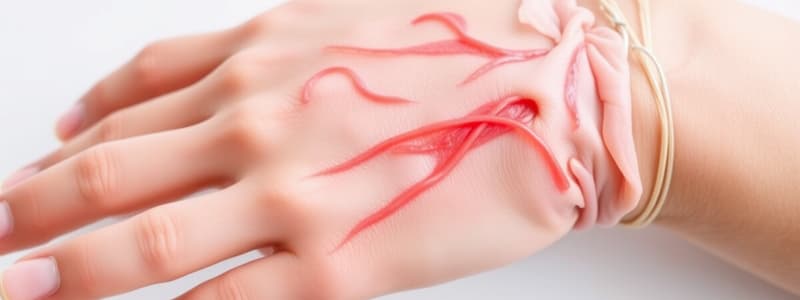Podcast
Questions and Answers
What type of nerve damage is often a result of physical injuries such as fractures?
What type of nerve damage is often a result of physical injuries such as fractures?
- Axonopathy
- Polyneuropathy
- Local Deficits (correct)
- Radiculoneuritis
What condition in horses is associated with left lateral recurrent laryngeal hemiplegia?
What condition in horses is associated with left lateral recurrent laryngeal hemiplegia?
- Cauda equina syndrome
- Stringhalt
- Roaring syndrome (correct)
- Coonhound paralysis
Which organism is known to cause bilateral deficits leading to paraparesis in dogs?
Which organism is known to cause bilateral deficits leading to paraparesis in dogs?
- Mycoplasma spp.
- Hypochaeris radicata
- Neospora caninum (correct)
- Rabies
What can lead to local nerve damage besides physical trauma?
What can lead to local nerve damage besides physical trauma?
Which condition in horses is associated with a gait abnormality characterized by a jerky or slapping motion?
Which condition in horses is associated with a gait abnormality characterized by a jerky or slapping motion?
What is a common cause of unilateral neurological deficits?
What is a common cause of unilateral neurological deficits?
What is the primary characteristic of diffuse deficits or polyneuropathies?
What is the primary characteristic of diffuse deficits or polyneuropathies?
Which treatment may be effective for infections caused by Neospora caninum?
Which treatment may be effective for infections caused by Neospora caninum?
Study Notes
Local Deficits & Localisation
- Damage to specific nerves often results from physical injuries or conditions affecting nerve function.
- Physical damage can stem from crush, severance, or avulsion injuries, as seen with radial nerve paralysis after fractures.
- Iatrogenic injury may occur due to injections, while compression injuries can happen during dystocia in cows, causing obturator nerve paralysis and affecting adductor muscle function.
Axonopathies
- Axonopathies predominantly affect the longest nerves, complicating axonal health maintenance over extensive distances.
- In horses, left lateral recurrent laryngeal hemiplegia (roaring syndrome) leads to weakened muscles and vocal fold flaccidity during breathing.
- Stringhalt, characterized by a jerky gait often linked to false dandelion ingestion, results in abnormal foot placement and may present bilaterally, leading to a "bunny hop" gait in affected animals globally.
Infarction and Neoplastic Invasion
- Infarction and tumor invasion can cause localized nerve damage, impacting nerve functionality at specific sites.
Regional Deficits
Unilateral Deficits
- Unilateral deficits may arise from nerve plexus damage, such as brachial avulsion in dogs due to front limb trauma.
- Spinal cord damage can produce neurological deficits extending along one side of the body, distal to the spinal lesion.
- Inflammation from rabies in horses can induce unilateral limb deficits, affecting nerve roots and leading to symptoms like paresthesia.
Bilateral Deficits
- Neospora caninum infection in dogs triggers radiculoneuritis and ganglioneuritis in the lumbosacral region.
- This condition results in progressive paraparesis with hind muscle atrophy and may also compromise spinal cord and skeletal muscle health.
- Early intervention with clindamycin or trimethoprim-sulfa can be effective. This infection may affect individual animals or entire litters.
Diffuse Deficits of Peripheral Nerves (Polyneuropathies)
- Polyneuropathies are primarily recognized in humans with conditions like diabetic neuropathy, leprosy, and autoimmune diseases such as myasthenia gravis, often exacerbated by chemotherapy or radiation.
- Idiopathic polyneuropathies have been identified in dogs and horses, with notable examples including coonhound paralysis in dogs and cauda equina syndrome in horses, although many common forms have not been documented in Australia.
Studying That Suits You
Use AI to generate personalized quizzes and flashcards to suit your learning preferences.
Description
This quiz covers the principles of neurological deficits due to local damage, including various types of physical injuries and their consequences. Explore conditions such as radial nerve paralysis and axonopathies, as well as their effects on nerve function. Understand how these issues relate to clinical practice and diagnosis.




